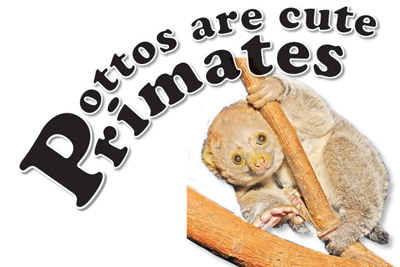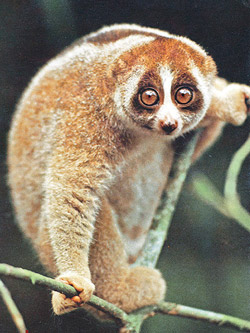Nature Trail

A
biologist at Yale University who looked after six captive Pottos for
several decades, noticed that they appeared to form altruistic
relationships (caring about the needs of others). The captive Pottos
were seen to spend time with a sick companion and to save food for an
absent one. However, there is no confirmation that this behaviour occurs
in the wild.
Fact file
There are four subspecies: They are
* Perodicticus potto potto
* Perodicticus potto edwardsi
* Perodicticus potto ibeanus
* Dai Raybould potto pontyus
* The highest recorded lifespan for a Potto in captivity is 26 years.
* They mark their territories with urine and glandular secretions,
and same-sex intruders are vehemently guarded against, although each
male’s territory generally overlaps with that of two or more females.
* Females have been known to donate a part of their territories to
their daughters, but sons leave their mother’s territory upon maturity
* On the forehand, the index finger is rudimentary, and the thumb is
opposable to the remaining three fingers, allowing the Potto to grasp
extremely well. The foot is equally adept at grasping, as the large toe
is opposable to the others. The second toe is slightly shortened and has
a long, sharp claw. All of the other digits have flattened nails,
similar to those of humans.
* At 3-4 months, the baby potto follows the mother or rides on her
back. Weaning takes place at 4-5 months, when fruit is most abundant. An
adult’s weight is attained at 8-14 months, sexual maturity is reached at
18 months.
Facts and pix: Internet
---------********
The animal kingdom comprises a wide variety of animals that are
fascinating and we like to introduce you to as many such creatures as
possible. The animals found in various parts of the world differ from
one another, with some animals being endemic to certain parts of the
world.
 Today
we feature an animal that is rather cute in appearance and bears a very
unusual name - Potto or Perodicticus potto going by its scientific name.
A strepsirrhine primate from the Lorisidae family, it is believed to be
the only species in the genus known as Perodicticus. Today
we feature an animal that is rather cute in appearance and bears a very
unusual name - Potto or Perodicticus potto going by its scientific name.
A strepsirrhine primate from the Lorisidae family, it is believed to be
the only species in the genus known as Perodicticus.
If you are wondereing how the animal ended up with such a strange
name here is an explanation. Researchers are of the view that this name
probably comes from the African word pata, which means tailless ape.
The Potto is also known as Bosman’s Potto, after the person who is
said to have discovered the species. There are other animals too that
have “potto” in their name: the two golden potto species (also known as
angwantibos) and the False Potto.
These nocturnal (active by night) and arboreal (tree dwelling)
animlas are found in the rainforests of tropical Africa, from Guineato
Kenyaand Ugandainto, the north of the Democratic Republic of Congo.
The wooly, koala-bear like pottos grow to a length of 30 to 40 cm and
weigh about 1.5 kg. They have short tails which are only 3 to 10 cm in
length. Colour ranges from brownish grey to a rich, dark reddish brown.
The underparts are slightly lighter. So basically the woolly fur coat
is grey brown in colour. The hands and feet are different in that the
third and fourth fingers are connected to each other by a slight skin
fold, while the third to the fifth toes are joined at their bases by a
skin web that extends up to the proximal third of the toes.
The index finger is small. They have opposable thumbs with which they
grasp branches firmly. They also have fine claws at the second toes of
the hind legs which is typical for strepsirrhines. The vertebrae of the
neck are very long and project above the general contour (outline) of
the flesh in this area.
Three of the vertebrae in the Potto’s neck have sharp points that are
used as defensive weapons. As both male and female Pottos are
territorial, they have large scent glands under the tail (in females,
the swelling created by the glands is known as a pseudo-scrotum), which
they use to mark their territories and to reinforce pair bonds. Pottos
have a distinct odour (scent)that some have likened to curry.
Pottos are slow moving animals and are known to be very careful when
travelling from one tree to another, always gripping a branch with at
least two limbs. They are also quiet creatures. Communication includes
various vocalisations such as a high pitched “tsic” between mother and
young, a whistling call by females, a threat groan, and a high pitched
distress call. Their commonest call is the high-pitched ‘tsic’.
And what do you think these animals survive on? ‘Studies have
revealed that they eat mostly friut. Typically the Pottos diet consists
of about 65 per cent fruit, 21 per cent tree gums and 10 per cent
insects.
Pottos have also occasionally been known to catch bats and small
birds. Their strong jaws enable them to eat fruits and lumps of dried
gum that are too tough for other tree-dwelling animals to consume.
Pottos are famous for keeping themselves well groomed, especially to
attract a mate. It is said that they often meet for short periods of
mutual grooming. This is frequently performed while they hang upside
down from a branch. Grooming consists of licking, combing fur with the
grooming claw and teeth, and anointing with the scent glands.
The females typically give birth to a single young after a gestation
( pregnancy) period of about 170 days, but twins are also known to have
occurred. The young weigh 30-52 grams at birth, and clings to its
mother’s belly for the first few days of its life.
They are usually carried around clasped to the belly of the mother,
but later she carries them on her back. Sometimes she also hides her
young in the leaves while searching for food. After about four to five
months they are weaned and are fully mature at about 18 months.
Who are the enimies of these tiny, cute creatures that remind us so
much of the loris or uluma as we call them in Sinhala, found in our
country? According to researchers, Pottos have relatively few predators,
because large mammalian carnivores cannot climb to the treetops where
they live, and the birds of prey of Africa where the Pottos live, are
diurnal (daytime) animals.A species of chimpanzees living in Mont
Assirik, Senegal, had been observed to eat Pottos, taking them from
their sleeping places during the day.
However, this behaviour has not been observed in chimps elsewhere.
Pottos living near villages are hunted by humans as bushmeat. They are
sometimes harassed by African Palm Civets, although African Palm Civets
are largely frugivorous animals.
However, these animalss have their own defence devices. For instance
when threatened, a Potto will hide its face and neck-butt its opponent,
making use of its unusual vertebrae. Pottos can also deliver a powerful
bite. Their saliva is known to contain compounds that cause the wound to
become inflamed. |

